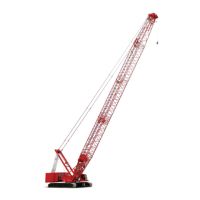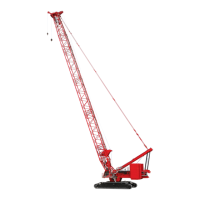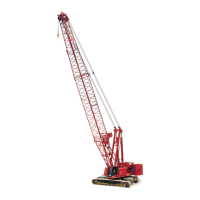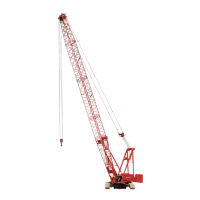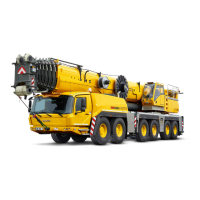Do you have a question about the Manitowoc MLC90A-1 and is the answer not in the manual?
| Engine | Cummins QSB6.7 |
|---|---|
| Engine Power | 275 hp |
| Engine Model | Cummins QSB6.7 |
| Luffing Jib Length | 30 ft (9.1 m) |
| Counterweight | 40, 000 lbs (18, 144 kg) |
| Maximum Lift Capacity | 90 US tons (81.6 metric tons) |
| Fixed Jib Length | 30 ft (9.1 m) |
| Maximum Load Capacity | 90 US tons (81.6 metric tons) |
General data specific to the crane, including basic specifications.
Information regarding the various weights of the crane and its components.
Details on the physical dimensions of the crane.
Procedure for new owners to register their crane.
Guidance on locating a Manitowoc dealer for support.
Information on how to identify the crane's model and serial number.
Explanation of terms like front, rear, left, and right as used in the manual.
Details and diagrams identifying major crane components and their locations.
Tables for converting between English and Metric units for various measurements.
Explains the importance of safety messages, symbols, and signal words used in the manual.
Information on maintaining and ordering safety and information signs for the crane.
Details on safe access points on the crane, including warnings about crush hazards.
Procedures and warnings for safely getting on or off the crane.
Emphasizes the owner's responsibility for providing fall protection equipment.
Guidelines for storing operator manuals and capacity charts within the crane cab.
General principles and responsibilities for safe crane operation and maintenance.
Defines who is qualified to operate the crane and the owner's responsibility for training.
Rules and guidelines for operator conduct during crane operations.
Safe practices for handling loads, including size, attachment, and movement.
Standard hand signals and audible signals for controlling crane operations.
Lists and describes the crane's safety devices and procedures if they malfunction.
Describes Category 1 and Category 2 operational aids and their maintenance requirements.
Critical safety procedures and regulations for working near electrical hazards.
Steps to follow in case of accidental electrical contact with energized power sources.
General principles and responsibilities for safe maintenance practices.
Critical safety precautions and procedures for disassembling boom sections to prevent collapse.
Policy and regulations regarding the use of cranes for personnel lifting.
Safety warnings and considerations for operating cranes on barges or platforms.
Requirements for regular inspection of barge-mounted cranes to prevent failure.
Illustrates standard hand signals used for controlling crane operations, compliant with ASME B30.5.
Identifies symbols found on the crane's control consoles and their meanings.
Overview of the controls and indicators located within the operator's cab.
Description and operation of controls located on the left console in the operator's cab.
Description and operation of controls located on the right console in the operator's cab.
Details the switches and controls found on the overhead console in the cab.
Explains the function and operation of the engine foot throttle and free fall brake pedals.
Step-by-step instructions for safely starting the crane's engine and initial system checks.
Detailed procedure for operating the boom hoist to raise and lower the boom.
Step-by-step instructions for safely operating the crane's swing function.
Procedure for operating the load drums for lifting loads using full power.
Detailed procedure for operating the load drums in free fall mode for specific applications.
Instructions and safety precautions for traveling the crane, including turning and speed control.
Steps for safely shutting down and securing the crane when leaving it unattended.
Information on configurations and limitations for traveling the crane at low clearance.
Precautions and limitations for operating the crane in cold weather conditions.
Procedures for installing, operating, and turning off the AC generator and power supply.
Important notes and requirements for experienced personnel performing assembly and disassembly.
Instructions for safely handling crane components using lifting lugs and slings.
Details the configuration of the crane for shipping, including dimensions and weights.
Lists the components that enable the crane to assemble and disassemble itself.
Explains the controls for self-erect operations located on the remote control and in the cab.
Checks to be performed before starting the engine upon arrival at the job site.
Procedures for assembling the crane, including trailer unloading and crawler steps.
Detailed steps for extending the crane's crawlers, including lubrication and shims.
Procedure for installing the hook-and-weight ball onto the boom butt.
Procedures for assembling the boom and jib, either with the crane or an assist crane.
Steps for installing carbody counterweight, using the boom butt and chain slings.
Procedure for assembling the crane counterweight onto the counterweight tray.
Further steps for installing crane counterweight, including boom stop preparation and remote control use.
Procedures for removing carbody counterweight, particularly for Series 2.
Procedures for disassembling the jib and boom, with or without an assist crane.
Detailed instructions for installing wire rope, including specifications and storage.
Step-by-step instructions for anchoring wire rope to the hoist drums.
Procedures for winding wire rope onto the drum correctly to prevent damage and ensure proper function.
Detailed instructions for anchoring wire rope to a wedge socket using specific methods.
Information on load line reeving, including guide sheaves and dead end locations.
Procedure for tying back the load block when not in use to prevent swinging.
Steps to connect boom pendants to the equalizer, ensuring proper sequence.
Steps to disconnect the boom butt from the main boom, with safety warnings.
Steps to configure the RCL/RCI system for the crane setup.
Instructions for installing the optional boom top position light and wind speed indicator.
Steps for installing block-up limit components on boom points for safety.
Steps for installing the jib bottom onto the boom top.
Instructions for installing jib inserts between the jib bottom and jib top.
Procedure for installing the jib top onto the jib bottom or jib insert.
Steps for installing jib and backstay pendants to connect the jib to the boom.
Detailed procedure for safely raising the boom, including pre-raising checks.
Guidelines for securing crane components onto trailers for safe transport.
General information and reference to detailed lubrication procedures.
Reference to a product guide for recommended lubricants and coolants.
Reference to a comprehensive checklist for inspection and maintenance tasks.
Reference to a bulletin for maintenance procedures specific to fiberglass components.
